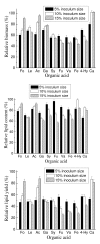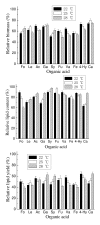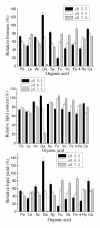Effect of organic acids on the growth and lipid accumulation of oleaginous yeast Trichosporon fermentans
- PMID: 22260291
- PMCID: PMC3296627
- DOI: 10.1186/1754-6834-5-4
Effect of organic acids on the growth and lipid accumulation of oleaginous yeast Trichosporon fermentans
Abstract
Background: Microbial lipids have drawn increasing attention in recent years as promising raw materials for biodiesel production, and the use of lignocellulosic hydrolysates as carbon sources seems to be a feasible strategy for cost-effective lipid fermentation with oleaginous microorganisms on a large scale. During the hydrolysis of lignocellulosic materials with dilute acid, however, various kinds of inhibitors, especially large amounts of organic acids, will be produced, which substantially decrease the fermentability of lignocellulosic hydrolysates. To overcome the inhibitory effects of organic acids, it is critical to understand their impact on the growth and lipid accumulation of oleaginous microorganisms.
Results: In our present work, we investigated for the first time the effect of ten representative organic acids in lignocellulosic hydrolysates on the growth and lipid accumulation of oleaginous yeast Trichosporon fermentans cells. In contrast to previous reports, we found that the toxicity of the organic acids to the cells was not directly related to their hydrophobicity. It is worth noting that most organic acids tested were less toxic than aldehydes to the cells, and some could even stimulate the growth and lipid accumulation at a low concentration. Unlike aldehydes, most binary combinations of organic acids exerted no synergistic inhibitory effects on lipid production. The presence of organic acids decelerated the consumption of glucose, whereas it influenced the utilization of xylose in a different and complicated way. In addition, all the organic acids tested, except furoic acid, inhibited the malic activity of T. fermentans. Furthermore, the inhibition of organic acids on cell growth was dependent more on inoculum size, temperature and initial pH than on lipid content.
Conclusions: This work provides some meaningful information about the effect of organic acid in lignocellulosic hydrolysates on the lipid production of oleaginous yeast, which is helpful for optimization of biomass hydrolysis processes, detoxified pretreatment of hydrolysates and lipid production using lignocellulosic materials.
Figures









Similar articles
-
Effects of alcohol compounds on the growth and lipid accumulation of oleaginous yeast Trichosporon fermentans.PLoS One. 2012;7(10):e46975. doi: 10.1371/journal.pone.0046975. Epub 2012 Oct 5. PLoS One. 2012. PMID: 23071683 Free PMC article.
-
Effects of aldehydes on the growth and lipid accumulation of oleaginous yeast Trichosporon fermentans.J Agric Food Chem. 2011 May 11;59(9):4606-13. doi: 10.1021/jf104320b. Epub 2011 Apr 11. J Agric Food Chem. 2011. PMID: 21443267
-
Tolerance of Trichosporon cutaneum to lignin derived phenolic aldehydes facilitate the cell growth and cellulosic lipid accumulation.J Biotechnol. 2022 Jan 10;343:32-37. doi: 10.1016/j.jbiotec.2021.09.009. Epub 2021 Sep 17. J Biotechnol. 2022. PMID: 34537255
-
Microbial lipid biosynthesis from lignocellulosic biomass pyrolysis products.Biotechnol Adv. 2022 Jan-Feb;54:107791. doi: 10.1016/j.biotechadv.2021.107791. Epub 2021 Jun 27. Biotechnol Adv. 2022. PMID: 34192583 Review.
-
Biodiesel production by various oleaginous microorganisms from organic wastes.Bioresour Technol. 2018 May;256:502-508. doi: 10.1016/j.biortech.2018.02.010. Epub 2018 Feb 6. Bioresour Technol. 2018. PMID: 29478783 Review.
Cited by
-
Effects of alcohol compounds on the growth and lipid accumulation of oleaginous yeast Trichosporon fermentans.PLoS One. 2012;7(10):e46975. doi: 10.1371/journal.pone.0046975. Epub 2012 Oct 5. PLoS One. 2012. PMID: 23071683 Free PMC article.
-
Microbial conversion of pyrolytic products to biofuels: a novel and sustainable approach toward second-generation biofuels.J Ind Microbiol Biotechnol. 2015 Dec;42(12):1557-79. doi: 10.1007/s10295-015-1687-5. Epub 2015 Oct 3. J Ind Microbiol Biotechnol. 2015. PMID: 26433384 Review.
-
Efficient conversion of acetate into lipids by the oleaginous yeast Cryptococcus curvatus.Biotechnol Biofuels. 2015 Nov 25;8:189. doi: 10.1186/s13068-015-0371-3. eCollection 2015. Biotechnol Biofuels. 2015. PMID: 26609324 Free PMC article.
-
Wood-feeding termite gut symbionts as an obscure yet promising source of novel manganese peroxidase-producing oleaginous yeasts intended for azo dye decolorization and biodiesel production.Biotechnol Biofuels. 2021 Dec 4;14(1):229. doi: 10.1186/s13068-021-02080-z. Biotechnol Biofuels. 2021. PMID: 34863263 Free PMC article.
-
Characterization of newly isolated oleaginous yeasts - Cryptococcus podzolicus, Trichosporon porosum and Pichia segobiensis.AMB Express. 2014 Mar 18;4:24. doi: 10.1186/s13568-014-0024-0. eCollection 2014. AMB Express. 2014. PMID: 24949259 Free PMC article.
References
-
- Demirbas A. Progress and recent trends in biofuels. Prog Energy Combust Sci. 2007;33:1–18. doi: 10.1016/j.pecs.2006.06.001. - DOI
-
- Xue FY, Zhang X, Luo H, Tan TW. A new method for preparing raw material for biodiesel production. Process Biochem. 2006;41:1699–1702. doi: 10.1016/j.procbio.2006.03.002. - DOI
-
- Adamczak M, Bornscheuer U, Bednarski W. The application of biotechnological methods for the synthesis of biodiesel. Eur J Lipid Sci Technol. 2009;111:800–813. doi: 10.1002/ejlt.200900078. - DOI
-
- Moreton RS, editor. Single Cell Oil. Harlow, UK: Longman Scientific & Technical; 1988.
-
- Moreton R. Modification of fatty acid composition of lipid accumulating yeasts with cyclopropene fatty acid desaturase inhibitors. Appl Microbiol Biotechnol. 1985;22:42–45.
LinkOut - more resources
Full Text Sources
Other Literature Sources

